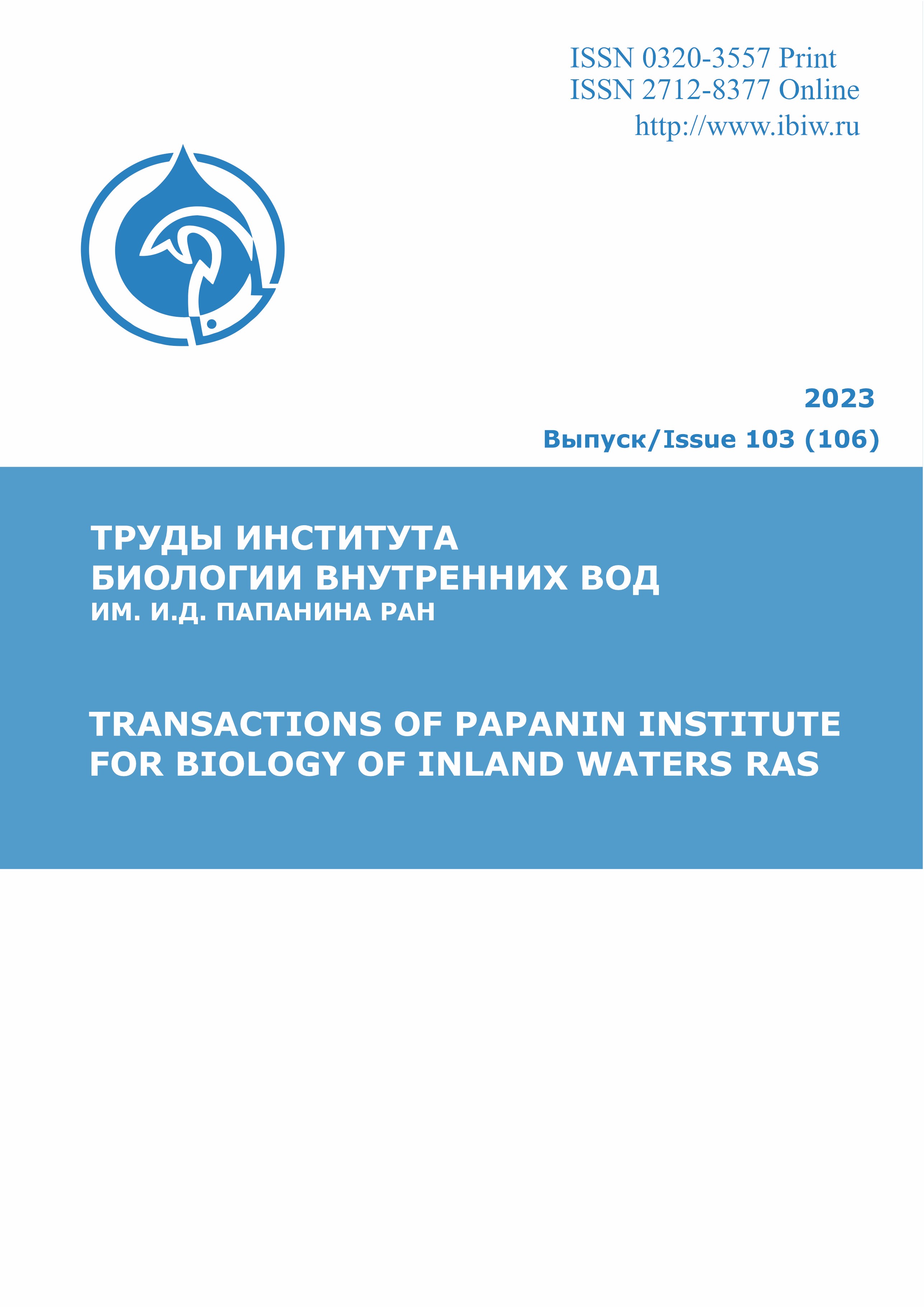The number of colony-forming units (CFU), composition and taxonomic structure of fungal biota in the bottom grounds of the Goryachinsk geothermal spring (Buryatia, Russian Federation) were determined by the cultural approach and the method of high-performance sequencing. The number of fungi in the grounds (0–3 cm) at the outlet of the spring and the watercourse at a short distance (3–100 m) varied in the range from several units to hundreds of CFU in 1 g. 70 isolates of fungi of 34 morphotypes were isolated by platings on nutrient media, of which 15 were identified to the species and 2 to the genus level. Its were thermophilic and thermotolerant species Aspergillus fumigatus, A. niger, A. nishimurae, A. terreus, Melanocarpus albomyces, Mycothermus thermophilus, Naganishia brisbanensis, Penicillium sp., Pseudothielavia terricola, Rhodotorula sp., Scedosporium apiospermum, Talaromyces flavus, Thermomyces dupontii, Thermothielavioides terrestris and Vishniacozyma carnescens. The method of high-performance sequencing of the ITS2 rDNA site in the source soils revealed an order of magnitude greater diversity of fungi, 149 species of 132 genera, and a total of 160 species were detected by both approaches. The number of identified operational-taxonomic units (OTE) to the species was 64.4%. In addition to ascomycetes and basidiomycetes, which were detected by platings on nutrient media, DNA barcoding showed the presence of representatives of the Phylums Mucoromycota, Mortierellomycota, Zoopagomycota, Chytridiomycota, Rozellomycota in the grounds. Moreover, among the fungi established by high-performance sequencing were not only thermotolerants, but also species with different resistance to high temperatures and trophic orientation. The application of both approaches provided more detailed information about the diversity of fungal organisms in the hot spring. However, in order to identify the inhabitant species of such ecotopes, a thorough analysis of their physiological and biochemical properties (which for many taxa is absent in due to volume) and the use of other approaches are necessary.
fungi, thermal springs, bottom grounds
1. Bab'eva I.P., Chernov I.Yu. Biologiya drozhzhey. M.: Tovarischestvo nauch. izd. KMK. 2004. 221 s.
2. Bonch-Osmolovskaya E.A., Miroshnichenko M.L., Slobodkin A.I., Sokolova T.G., Karpov G.A., Kostrikina N.A., Zavarzina D.G., Prokof'eva M.I., Rusanov I.I., Pimenov N.V. Bioraznoobrazie anaerobnyh litotrofnyh prokariot v nazemnyh gidrotermah Kamchatki // Mikrobiologiya. 1999. T. 68. № 3. S. 398-407.
3. Bonch-Osmolovskaya E.A., Miroshnichenko M.L. Termofil'nye bakterii iz goryachih istochnikov Buryatii // Ekologicheskie problemy mikrobiologii i biotehnologii Baykal'skogo regiona: Tez. dokl. Mezhdunar. konf. Ulan-Ude: Izd-vo BNC SO RAN, 1995. S. 47-49.
4. Voronin L.V. Griby i gribopodobnye organizmy v presnovodnyh ekosistemah: uchebnoe posobie. Yaroslavl': “Filigran'”, 2023. 123 s.
5. GOST 11623-89. Torf i produkty ego pererabotki dlya sel'skogo hozyaystva. Metody opredeleniya obmennoy i aktivnoy kislotnosti. Moskva, 1990. 5 s.
6. GOST 26213-2021. Pochvy. Metody opredeleniya organicheskogo veschestva. Moskva, 2021. 7 s.
7. Gribkovye infekcii: rukovodstvo dlya vrachey. 2-e izd. M.: OOO “Izdatel'stvo “BINOM. Laboratoriya znaniy”, 2008. 480 s.
8. Dashieva Zh.D. Fitocenoticheskaya priurochennost' i opredelenie soderzhaniya flavonoidov v smilacine trehlistnoy. Rastitel'nyy mir Baykal'skoy prirodnoy territorii: sovremennoe sostoyanie i perspektivy issledovaniy: materialy regional'noy molodezhnoy nauchno-prakticheskoy konferencii. Ulan-Ude, 2014, S. 13-14.
9. Kochetkova T.V., Podosokorskaya O.A., El'cheninov A.G., Kublanov I.V. Raznoobrazie termofil'nyh prokariot v prirodnyh goryachih istochnikah Rossiyskoy Federacii // Mikrobiologiya. 2022. T. 91. № 1. S. 3-31. DOI:https://doi.org/10.31857/S0026365622010062.
10. Merkel' A.Yu., Podosokorskaya O.A., Sokolova T.G., Bonch-Osmolovskaya E.A. Raznoobrazie metanogennyh arhey v nazemnom goryachem istochnike 2012 (Dolina geyzerov, Kamchatka) // Mikrobiologiya. 2016. T. 85. № 3. S. 327-336. DOI:https://doi.org/10.7868/S0026365616030095.
11. Metodika vypolneniya izmereniy massovoy doli elementov v probah pochv, gruntov i donnyh otlozheniy metodami atomno-emissionnoy i atomno-absorbcionnoy spektrometrii. M-MVI-80-2008. Sankt-Peterburg. 2008. S. 27.
12. Namsaraev Z.B., Zayceva S.V., Dmitrieva O.M., Barhutova D.D. Struktura i funkcional'naya aktivnost' mikrobnyh matov termal'nogo istochnika Garga (Barguzinskaya kotlovina) // Vestnik Buryatskogo gosudarstvennogo universiteta. Biologiya, geografiya. 2011. № 4a. S. 231-239.
13. Naprasnikova E.V., Belozerceva I.A. Pochvy vostochnogo poberezh'ya ozera baykal i ih ekologo-mikrobiologicheskaya harakteristika // Vestnik Kamchatskogo gosudarstvennogo tehnicheskogo universiteta. 2020. №. 54. C. 108-116. DOI:https://doi.org/10.17217/2079-0333-2020-54-108-116.
14. Booth C. Fusarium. Laboratory guide to the identification of the major species. Surrey, England: C.M.I., Kew, 1977. 57 p.
15. Chen K.Y., Huang D.J., Liu C.C. The mycoflora of hot spring soil in northern Taiwan // Taiwania. 2003. Vol. 48. № 3. P. 203-211.
16. Chen M.Y., Chen Z.C., Chen K.Y., Tsay S.S. Fungal flora of hot springs of Taiwan (1): Wu-Rai // Taiwania. 2000. Vol. 45. № 2. P. 207-216.
17. Crous P.W., Braun U., Schubert K., Groenewald J.Z. The genus Cladosporium and similar dematiaceous hyphomycetes // Stud. Mycol. 2007. Vol. 58. P. 1-253.
18. De Hoog G.S., Guarro J., Gené J., Figueras M.J. Atlas of Clinical Fungi. 3rd edn. CBS-KNAW Fungal Biodiversity Centre, Utrecht, 2011. 1126 p.
19. Di Piazza S., Houbraken J., Meijer M., Cecchi G., Kraak B., Rosa E., Zotti M. Thermotolerant and thermophilic mycobiota in different steps of compost maturation // Microorganisms. 2020. Vol. 8. № 6. P. 880. DOI:https://doi.org/10.3390/microorganisms8060880.
20. Dijksterhuis J. Food Mycology. Heat-resistant ascospores. Eds.: Dijksterhuis J., Samson R.A. CRC Press, Boca Raton, 2007, pp. 101-117.
21. Domsch K.H., Gams W., Anderson T.-H. Compendium of soil fungi. IHW-Verlag, Eching, 2007. 672 p.
22. Ellis M.B. Dematiaceous Hyphomycetes. Surrey, England: C.M.I., Kew, 1971. 608 p.
23. Ghajari A., Latifi A., Lotfali E. Fungal contamination of improved hot springs in Mazandaran province, fall 2014 // Pejouhesh dar Pezeshki. 2017. Vol. 41. № 1. P. 50-55.
24. Ghajari A., Latifi A., Niyati M., Lotfali E. An Investigation of Fungal Contamination in Hot Springs of Mahallat City, Summer 2016 (Iran) // Qom University of Medical Sciences Journal. 2018. Vol. 11. № 12. P. 76-83.
25. Gleason F.H., Scholz B., Jephcott T.G., van Ogtrop F.F., Henderson L., Lilje O., Kittelmann S., Macarthur D.J. Key ecological roles for zoosporic true fungi in aquatic habitats // Microbiol. Spectrum. 2017. Mol. 5. № 2. P. 10-1128. DOI:https://doi.org/10.1128/microbiolspec.funk-0038-2016.
26. Guarro J., Kantarcioglu A.S., Horré R., Rodriguez-Tudela J.L., Cuenca Estrella M., Berenguer J., de Hoog G.S. Scedosporium apiospermum: changing clinical spectrum of a therapy-refractory opportunist // Med. Mycol. 2006. Vol. 44. № 4. P. 295-327. DOI:https://doi.org/10.1080/13693780600752507.
27. Grigoriev I.V., Cullen D., Goodwin S.B., Hibbett D., Jeffries T.W., Kubicek C.P., Kuske C., Magnuson J.K., Martin F., Spatafora J.W., Tsang A., Baker S.E. Fueling the future with fungal genomics // Mycology. 2011. Vol. 2, № 3. P. 192-209. DOI:https://doi.org/10.1080/21501203.2011.584577.
28. Kambura A.K., Mwirichia R.K., Kasili R.W., Karanja E.N., Makonde H.M., Boga H.I. Diversity of fungi in sediments and water sampled from the hot springs of Lake Magadi and Little Magadi in Kenya // Afr. J. Microbiol. Res. 2016. Vol. 10, № 10. P. 330-338.
29. Kirk P.M., Cannon P.F., Minter D.W., Stalpers J.A. Dictionary of the Fungi (10th edition). CABI, Wallingford, UK, 2008. 2600 p.
30. Klich M.A. Identification of Common Aspergillus Species. CBS, Utrecht, 2002. 528 p.
31. Lee H., Tang H. Evolutionary Genomics: Statistical and Computational Methods, Volume 1. Next-generation sequencing technologies and fragment assembly algorithms. Totowa, NJ: Humana Press, 2012. P. 155-174.
32. Lepere C., Domaizon I., Humbert J-F., Jardillier L., Hugoni M., Debroas D. Diversity, spatial distribution and activity of fungi in freshwater ecosystems // Peer J. 2019. Vol. 7. P. e6247. DOI:https://doi.org/10.7717/peerj.6247.
33. Maheshwari R., Bharadwaj G., Bhat M.K. Thermophilic fungi: their physiology and enzymes // Microbiol. Mol. Biol. Rev. 2000. Vol. 64. № 3. P. 461-488. DOI:https://doi.org/10.1128/mmbr.64.3.461-488.2000.
34. Nguyen N. H., Song Z., Bates S. T., Branco S., Tedersoo L., Menke J., Schilling J.S., Kennedy P. G. FUNGuild: an open annotation tool for parsing fungal community datasets by ecological guild // Fungal Ecol. 2016. Vol. 20. P. 241-248. DOI:https://doi.org/10.1016/j.funeco.2015.06.006.
35. Özdemir S.Ç., Uzel A. Bioprospecting of some hot springs and compost in West Anatolia regarding phytase producing thermophilic fungi // Sydowia. 2020. Vol. 72. P. 1-11. DOI:https://doi.org/10.12905/0380.sydowia72-2020-0001.
36. Raper K. B., Thom C. A manual of the Penicillia. Baltimore: The Williams and Wilkins Company, 1949. 878 p.
37. Raper K.B., Fennell D.I. The Genus Aspergillus. Baltimore: The Williams and Wilkins Company, 1965. 686 p.
38. Raper K.B., Thom C., Fennell D.I. A Manual of the Penicillia. New York and London: Hafner Publishing Company, 1968. 875 p.
39. Ramírez C. Manual and Atlas of the Penicillia. Amsterdam: Elsevier Biomedical Press, 1982. 874 p.
40. Redman R.S., Litvintseva A., Sheehan K.B., Henson J.M., Rodriguez R.J. Fungi from geothermal soils in Yellowstone National Park // Appl. Environ. Microbiol. 1999. Vol. 65, № 12. P. 5193-5197. DOI:https://doi.org/10.1128/AEM.65.12.5193-5197.1999.
41. Rifai M.A. A revision on the genus Trichoderma // Mycological Prpers. 1969. Vol. 116. P. 1-56.
42. Salano O.A., Makonde H.M., Kasili R.W., Wangai L.N., Nawiri M.P., Boga H.I. Diversity and distribution of fungal communities within the hot springs of soda lakes in the Kenyan rift valley // Afr. J. Microbiol. Res. 2017. Vol. 11, № 19. P. 764-775.
43. Samson R.A, Houbraken J. Phylogenetic and taxonomic studies on the genera Penicillium and Talaromyces // Stud. Mycol. 2011. Vol. 70. P. 1-183.
44. Schipper M.A. On certain species of Mucor with a key to all accepted species; On the genera Rhi-zomucor and Parasitella // Stud. Mycol. 1978. Vol. 17. P. 1-71.
45. Seifert K., Morgan-Jones G., Gams W., Kendrick B. The Genera of Hyphomycetes. CBS-KNAW Fungal Biodiversity Centre, Utrecht, 2011. 997 p.
46. Sharma N., Vyas G., Pathania S. Culturable diversity of thermophilic microorganisms found in hot springs of northern Himalayas and to explore their potential for production of industrially important enzymes // Scholars Acad. J. Biosci. 2013. Vol. 1, № 5. P. 165-178.
47. Singh P., Raghukumar C., Verma P., Shouche Y., Fungal community analysis in the deep-sea sediments of the Central Indian Basin by culture-independent approach // Microb. Ecol. 2011. Vol. 61. P. 507-517. DOI:https://doi.org/10.1007/s00248-010-9765-8.
48. Tanunchai B., Ji L., Schroeter S.A., Wahdan S.F.M., Hossen S., Delelegn Y., Buscot F., Lehnert A-S., Alves E.G., Hilke I., Gleixner G., Schulze E-D., Noll M., Purahong W. FungalTraits vs. FUNGuild: comparison of ecological functional assignments of leaf-and needle-associated fungi across 12 temperate tree species // Microb. Ecol. 2023. Vol. 85, № 2. P. 411-428. DOI:https://doi.org/10.1007/s00248-022-01973-2.
49. Velez P., Salcedo D.L., Espinosa-Asuar L., Gasca-Pineda J., Hernandez-Monroy A., Soto L. A. Fungal Diversity in Sediments From Deep-Sea Extreme Ecosystems: Insights Into Low- and High-Temperature Hydrothermal Vents, and an Oxygen Minimum Zone in the Southern Gulf of California, Mexico // Front. Mar. Sci. 2022. Vol. 9. P. 802634. DOI:https://doi.org/10.3389/fmars.2022.802634.
50. Von Arx J.A. The Genera of fungi sporulating in pure culture. 3rd edn. Vaduz: J. Cramer, 1981. 424 p.
51. Xu W., Gong L. F., Pang K. L., Luo Z. H. Fungal diversity in deep-sea sediments of a hydrothermal vent system in the Southwest Indian Ridge // Deep Sea Res., 2018. Vol. 131. Part I. P. 16-26. DOI:https://doi.org/10.1016/j.dsr.2017.11.001.








